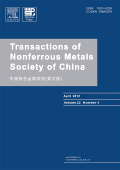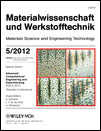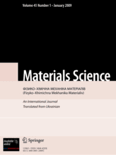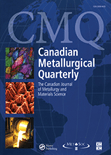
TRANSACTIONS OF NONFERROUS METALS SOCIETY OF CHINA
Scope & Guideline
Pioneering research in the realm of nonferrous materials.
Introduction
Aims and Scopes
- Advanced Materials Processing:
The journal reports on innovative processing techniques for nonferrous metals, including additive manufacturing, casting, and welding methods that enhance the performance and properties of metallic materials. - Mechanical Properties and Performance Analysis:
Research related to the mechanical behavior of nonferrous metals, including studies on tensile strength, ductility, fatigue resistance, and wear properties, is a core focus. - Corrosion and Environmental Resistance:
The journal includes studies on the corrosion behavior of nonferrous alloys and the development of protective coatings to enhance durability and performance in various environments. - Materials Characterization and Modeling:
Papers often present advanced characterization techniques and computational models to predict material behavior, phase transformations, and microstructural evolution. - Sustainability and Recycling:
Research on the recycling of nonferrous metals and the development of sustainable practices in metallurgy is increasingly emphasized, reflecting global trends towards environmental responsibility. - Nanostructured and Composite Materials:
The journal publishes studies on the development and application of nanostructured materials and composites that offer enhanced properties for specific applications.
Trending and Emerging
- Additive Manufacturing and 3D Printing:
There is a significant uptick in research related to additive manufacturing techniques for nonferrous metals, focusing on process optimization, material properties, and applications in aerospace and automotive industries. - High-Entropy Alloys and Novel Metal Systems:
The exploration of high-entropy alloys and novel metal compositions is trending, as researchers investigate their unique properties and potential applications in demanding environments. - Biodegradable and Eco-Friendly Materials:
Research on biodegradable magnesium alloys and other eco-friendly materials is on the rise, driven by the need for sustainable solutions in various applications, especially in biomedical fields. - Nanotechnology and Surface Engineering:
Studies involving nanostructured materials and surface modification techniques to enhance performance and functionality are increasingly being published. - Machine Learning Applications in Metallurgy:
The integration of machine learning techniques for predicting material behavior, optimizing processing parameters, and enhancing material design is gaining momentum. - Corrosion Resistance Innovations:
There is an increasing focus on developing advanced coatings and treatments that improve corrosion resistance, particularly for alloys used in harsh environments.
Declining or Waning
- Traditional Metallurgical Techniques:
Research focused on conventional methods of metal extraction and processing has declined, as the field shifts towards more advanced and sustainable technologies. - Basic Alloy Composition Studies:
There has been a noticeable decrease in studies solely focused on the basic composition of alloys without accompanying performance or processing innovations. - Physical Metallurgy of Bulk Materials:
The emphasis on theoretical aspects of physical metallurgy for bulk materials has waned, with a greater focus now on application-driven research and novel material systems. - Low-Temperature Processing Techniques:
Research on low-temperature processing methods has declined, possibly due to the increasing interest in high-temperature applications and the benefits they provide.
Similar Journals

MATERIALWISSENSCHAFT UND WERKSTOFFTECHNIK
Innovating Tomorrow's Materials Today.MATERIALWISSENSCHAFT UND WERKSTOFFTECHNIK, published by WILEY-V C H VERLAG GMBH, is a prominent journal dedicated to the field of materials science and engineering. With its ISSN 0933-5137 and E-ISSN 1521-4052, this journal serves as a vital resource for researchers and professionals engaged in exploring the intricate relationships between the properties of materials and their applications. Established in 1970 and continuing through 2024, the journal has been consistently recognized in various categories, achieving a Q3 ranking in 2023 across Condensed Matter Physics, Materials Science (miscellaneous), Mechanical Engineering, and Mechanics of Materials. Although it does not offer open access, its high-quality peer-reviewed content is fundamental to the advancement of knowledge within its three key areas: novel material development, material characterization, and application of materials in engineering contexts. As a driving force in the scientific community, MATERIALWISSENSCHAFT UND WERKSTOFFTECHNIK continues to cater to the curiosity of aspiring students, seasoned professionals, and researchers alike, facilitating a deeper understanding of the complexities of material technology.

MATERIALS SCIENCE
Exploring Breakthroughs in Materials Research.MATERIALS SCIENCE, a prominent journal published by SPRINGER, serves as a vital resource for researchers, professionals, and students in the fields of materials science, mechanical engineering, and condensed matter physics. With its ISSN 1068-820X and E-ISSN 1573-885X, this journal has been dedicated to sharing innovative research since its inception in 1993, and it continues to publish groundbreaking findings through 2024. Although it operates as a traditional subscription-based journal, its ranking in the Q3 quartile across multiple scientific categories, including Condensed Matter Physics, Materials Science, Mechanical Engineering, and Mechanics of Materials, signifies its relevance and impact in the academic community. Notably, its Scopus classifications reveal a competitive standing among its peers, ranking within the 25th to 33rd percentiles across various engineering and physics disciplines. The journal remains a key platform for disseminating valuable insights, fostering collaboration, and advancing the understanding of materials science.

METALLURGICAL AND MATERIALS TRANSACTIONS B-PROCESS METALLURGY AND MATERIALS PROCESSING SCIENCE
Shaping the Future of Materials Science Through Rigorous ResearchMETALLURGICAL AND MATERIALS TRANSACTIONS B-PROCESS METALLURGY AND MATERIALS PROCESSING SCIENCE, published by Springer, serves as a pivotal platform in advancing the field of materials science, focusing specifically on the intricacies of process metallurgy and materials processing. With an ISSN of 1073-5615 and an E-ISSN of 1543-1916, this esteemed journal boasts an impressive standing with its 2023 category quartiles, ranking Q2 in Condensed Matter Physics, Materials Chemistry, and Mechanics of Materials, while achieving a top-tier Q1 classification in Metals and Alloys. Positioned in the United States, the journal has been publishing leading research since its inception, with converged years spanning from 1973 to 1979 and 1995 to 2024. The journal's robust impact within its fields is reflected in its Scopus rankings, notably ranking #42 out of 176 in Materials Science with a 76th percentile. Though not an open access journal, its comprehensive and high-quality research articles cater to the needs of researchers, professionals, and students, ensuring they remain at the forefront of advancements in metallurgy and materials processing science.

Materiali in Tehnologije
Innovating Insights in Metals and PolymersMateriali in Tehnologije is a distinguished peer-reviewed journal dedicated to the field of materials science, focusing specifically on metals and polymers. Published by the Institute for Metals and Materials Technology in Slovenia, this open-access journal has been at the forefront of disseminating research findings and innovative technologies since 2000. With a current impact factor that reflects its increasing visibility in the academic community, Materiali in Tehnologije serves as an invaluable resource for researchers, professionals, and students alike, encompassing a wide array of studies in the categories of Metals and Alloys, as well as Polymers and Plastics. The journal is indexed in Scopus, highlighting its relevance and contribution to the field, particularly with its ranks of Q3 in Metals and Alloys and Q4 in Polymers and Plastics. As it converges towards 2024, Materiali in Tehnologije continues to be a pivotal platform for knowledge exchange, encouraging advancements in materials research and technology.

KOVOVE MATERIALY-METALLIC MATERIALS
Exploring Innovations in Materials ChemistryKOVOVE MATERIALY-METALLIC MATERIALS, published by REDAKCIA KOVOVE MATERIALY, is a prominent journal embedded within the field of materials science, focusing particularly on metallic materials. With a history dating back to 1968, this Slovakian journal has made significant contributions to the understanding of materials chemistry, mechanical engineering, and the mechanics of materials. While currently classified in the Q4 category for Materials Chemistry and Mechanical Engineering, and Q3 for Metals and Alloys, it aims to provide a platform for high-quality research and novel findings in these domains. Furthermore, the journal is indexed within Scopus, reflecting its engagement with the global scientific community and its role in disseminating pivotal studies. Researchers, professionals, and students will find crucial insights and developments in the field, making it a valuable resource for those seeking to enhance their understanding of metallic materials and their applications.

Journal of Metals Materials and Minerals
Catalyzing Discoveries in Metals, Ceramics, and BiomaterialsJournal of Metals Materials and Minerals (ISSN: 0857-6149) is a renowned academic publication dedicated to the interdisciplinary fields of metallurgical science, materials engineering, and mineralogy. Published by Chulalongkorn University, Metallurgy & Materials Science Research Institute in Thailand, this journal serves as a pivotal platform for researchers to disseminate their findings and explore innovative applications related to metals, ceramics, polymers, and biomaterials. Although the journal does not currently adopt an open-access model, it provides insightful content that facilitates knowledge sharing among professionals and academics alike. The journal has established its credibility with impressive Scopus ranking percentiles, particularly in categories such as Metals and Alloys and Ceramics and Composites. With an emphasis on advancing the understanding of materials science from 2017 to 2024, the Journal of Metals Materials and Minerals remains an essential resource for those striving to contribute to and stay informed about the latest trends and breakthroughs in these dynamic fields.

CANADIAN METALLURGICAL QUARTERLY
Innovating the Future of Metals and Alloys.Canadian Metallurgical Quarterly is a prestigious scholarly journal published by Taylor & Francis Ltd, dedicated to the field of metallurgical engineering and materials science. With a rich history dating back to its inception in 1962 and continuing through its most recent publications, this journal serves as a vital platform for the dissemination of innovative research, advancements, and critical reviews in metallurgy, metals, and alloys. Positioned strategically within the academic community, it holds a significant impact factor and is currently rated in the Q2 category for Metals and Alloys, and Q3 in Industrial and Manufacturing Engineering as of 2023, showcasing its authoritative role in these disciplines. Although it does not offer open access, the journal remains widely recognized for its rigorous peer-review process, ensuring that published work adheres to the highest standards of scientific quality. Researchers, professionals, and students alike will find invaluable insights and contributions that drive the field forward.

STEEL RESEARCH INTERNATIONAL
Advancing the Future of Metals and Alloys.STEEL RESEARCH INTERNATIONAL, published by WILEY-V C H VERLAG GMBH, is a premier journal that serves as a vital source of knowledge in the fields of condensed matter physics, materials chemistry, and metal and alloy research. With an ISSN of 1611-3683 and an E-ISSN of 1869-344X, this journal provides open access options that enhance its visibility and accessibility. Recognized for its scientific merit, it currently holds a Q2 ranking across multiple categories including Condensed Matter Physics and Materials Chemistry. This translates to an exceptional placement within the 64th percentile for Metals and Alloys and substantial recognition in other related fields according to Scopus rankings. By bridging theoretical concepts and practical applications, STEEL RESEARCH INTERNATIONAL aims to foster innovative research and dissemination of knowledge among researchers, professionals, and students focused on advancing the metallurgy and materials science domains. With a commitment to remain at the forefront of research from 2003 to 2024, the journal is poised to continue shaping the future of steel and alloy studies.

Metals
Shaping the future of materials science through rigorous research.Metals is an esteemed open access journal published by MDPI, focusing on the diverse field of metallurgical science and its applications. Since its inception in 2011, the journal has provided a platform for the dissemination of high-quality research regarding the behavior, processing, and properties of metals and alloys. With an E-ISSN of 2075-4701, it has quickly established itself within the scientific community, achieving a remarkable Q1 ranking in the realm of Metals and Alloys and a Q2 rank in general Materials Science as of 2023. The journal is situated in Switzerland and is committed to the principles of open access, ensuring that findings are accessible to a broad audience without subscription barriers. With its notable impact factor and a strong emphasis on innovative research, Metals serves as an essential resource for researchers, professionals, and students seeking to advance their knowledge and understanding in the ever-evolving landscape of metallurgical studies.

METALS AND MATERIALS INTERNATIONAL
Unveiling the potential of metals and materials for tomorrow's technologies.METALS AND MATERIALS INTERNATIONAL, published by the Korean Institute of Metals and Materials, is a prestigious journal dedicated to the advancement of research in the fields of materials science and engineering. With an ISSN of 1598-9623 and a robust e-ISSN of 2005-4149, this journal has established itself as a crucial platform for disseminating innovative findings and key advancements that span condensed matter physics, materials chemistry, mechanics of materials, and the technology of metals and alloys. Its Q1 rankings in multiple categories attest to its high impact and relevance in the academic community, placing it among the top journals in its fields with Scopus rankings that reflect a strong international footprint. Here, researchers, professionals, and students can access cutting-edge research and insights, fostering collaboration and exploration of new materials and their applications. With a commitment to excellence and a convergence of knowledge from 1996 to 2024, METALS AND MATERIALS INTERNATIONAL continues to enhance our understanding of materials and their transformative impact on technology and engineering.